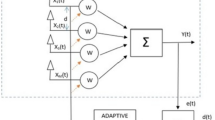Abstract
In this paper, it is proved that in multi-conductor power line communication (PLC), spatial multiplexing can be achieved not only in different transmission modes but also in a same transmission mode, which means that spatial multiplexing technique can suppress the interference from any transmission modes. With this conclusion, a co-channel interference (CCI) suppression method based on oblique projection is proposed for multi-conductor PLC. In this method, the oblique projection operator which maps the received signal to the signal space along the interference space is estimated based on second-order statistics of the received data, and then the CCI can be suppressed by the oblique projection operator. The simulation results reveal the validity of the proposed method.












Similar content being viewed by others
References
Galli S, Scaglione A, Wang ZF (2011) For the grid and through the grid: the role of power line communications in the smart grid. Proc IEEE 99(6):998–1027
Galli S, Scaglione A, Wang ZF (2010) Power line communications and the smart grid. Proc. IEEE Int. Conf. Smart Grid Communications, Gaithersburg, Maryland, USA., pp 303–308
Gupta BB, Akhtar T (2017) A survey on smart power grid: frameworks, tools, security issues, and solutions. Ann Telecommun 517–549
Degardin V, Laly P, Lienard M, Degauque P (2014) Investigation on power line communication in aircrafts. IET Commun 8(10):1868–1874
Schneider D, Schwager A (2011) Implementation and results of a MIMO PLC feasibility study. Proc. IEEE Int. Symp. Power Line Communications and its Applications, Udine, pp 54–59
Berger LT, Schwager A, Pagani P, Schneider DM (2014) MIMO power line communications. IEEE Commun Surv Tutorials 99(3):11–18
Stadelmeier L, Schill D, Schwager A, Schneider D, Speidel J (2008) MIMO for inhome power line communications, Proc. Int. Conf. ITG. Source and Channel coding, Ulm, pp 78–63
Hashmat R, Pagani P (2011) A channel model for multiple input multiple output in-home power line networks, Proc. IEEE Int. Symp. Power Line Communications and its Applications, Udine, pp 48–53
Pagani P, Schwager A (2016) A statistical model of the in-home MIMO PLC channel based on European field measurements[J]. IEEE J Sel Areas Commun 34(7):2033–2044
Versolatto F, Tonello AM (2011) An MTL theory approach for the simulation of MIMO power-line communication channels. IEEE Trans Power Deliv 26(3):1710–1717
Tonello AM, Zheng T (2009) Bottom-up transfer function generator for broadband PLC statistical channel modelling, Proc. IEEE Int. Symp. Power Line Communications and its Applications, Dresden, pp 7–12
Amirshahi P, Kavehrad M (2005) Transmission channel model and capacity of overhead multi-conductor medium-voltage power-lines for broadband communications. Proc. IEEE Consumer Communications and Networking Conference, Nara, pp 354–358
Schwager A (2011) MIMO PLC: theory, measurements and system, Proc. IEEE Int. Symp. Power Line Communications and its Applications, Udine, pp 48–53
HomePlug Alliance (2012) HomePlug AV specification version 2.0
International Telecommunications Union (ITU) (2011) ITU-T recommendation G.9963, Unified high-speed wire-line based home networking transceivers-multiple input/multiple output (MIMO)
Andrews JG, Choi W, Heath RW (2007) Overcoming interference in spatial multiplexing MIMO cellular networks. IEEE Trans Wirel Commun 14(6):95–104
Fan J, Yin Q, Wang W (2010) Oblique projection-based robust linear receiver for spatial multiplexing systems with unknown co-channel interference. Proc. IEEE Wireless Communications and Networking Conference, Ottawa, pp 68–73
Sun YJ, Pratt T (2013) Narrowband PLC SIMO-based interference suppression with zero-forcing. IEEE Trans Power Deliv 28(4):2022–2029
Middleton D (1983) Canonical and quasi canonical probability models of class A interference. IEEE Trans Electromagn Compat 25(2):76–106
Behrens RT, Scharf LL (1994) Signal processing applications of oblique projection operators. IEEE Trans Signal Process 42(6):1413–1424
Kinjo S (2009) Time domain channel estimation schemes for OFDM systems with multiple antenna transmissions. Proc. IEEE Int. Symp. Intelligent Signal Processing and Communication Systems, Kanazawa, pp 232–235
Tong L, Xu GH, Kailath T (1991) A new approach to blind identification and equalization of multipath channels. Proc. Conf. Signals, Systems and Computers, Pacific Grove, California, USA., pp 856–860
Shin CY, Heath RW, Powers EJ (2007) Blind channel estimation for MIMO-OFDM systems. IEEE Trans Veh Technol 56(2):670–685
Moulines E, Duhamel P, Cardoso J, Mayrargue S (1995) Subspace methods for the blind identification of multi-channel FIR filters. IEEE Trans Signal Process 43(2):516–525
Funding
This work was supported by the National Natural Science Foundation of China (Nos. 61771091, 61871066), National High Technology Research and Development Program (863 Program) of China (No. 2015AA016306), Natural Science Foundation of Liaoning Province of China (No. 20170540159), and Fundamental Research Funds for the Central Universities of China (No. DUT17LAB04).
Author information
Authors and Affiliations
Corresponding author
Rights and permissions
About this article
Cite this article
Hu, X., Chen, Z., Yin, F. et al. Oblique projection-based interference suppression for MIMO power line communication. Ann. Telecommun. 74, 211–221 (2019). https://doi.org/10.1007/s12243-018-0667-y
Received:
Accepted:
Published:
Issue Date:
DOI: https://doi.org/10.1007/s12243-018-0667-y




